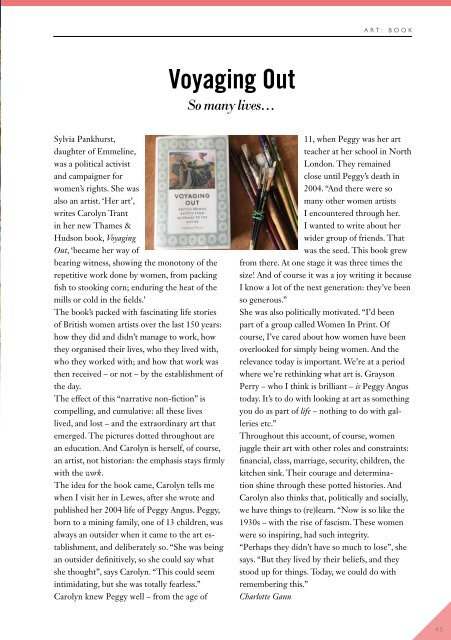Viva Lewes Issue #157 October 2019
You also want an ePaper? Increase the reach of your titles
YUMPU automatically turns print PDFs into web optimized ePapers that Google loves.
ART: BOOK<br />
Voyaging Out<br />
So many lives…<br />
Sylvia Pankhurst,<br />
daughter of Emmeline,<br />
was a political activist<br />
and campaigner for<br />
women’s rights. She was<br />
also an artist. ‘Her art’,<br />
writes Carolyn Trant<br />
in her new Thames &<br />
Hudson book, Voyaging<br />
Out, ‘became her way of<br />
bearing witness, showing the monotony of the<br />
repetitive work done by women, from packing<br />
fish to stooking corn; enduring the heat of the<br />
mills or cold in the fields.’<br />
The book’s packed with fascinating life stories<br />
of British women artists over the last 150 years:<br />
how they did and didn’t manage to work, how<br />
they organised their lives, who they lived with,<br />
who they worked with; and how that work was<br />
then received – or not – by the establishment of<br />
the day.<br />
The effect of this “narrative non-fiction” is<br />
compelling, and cumulative: all these lives<br />
lived, and lost – and the extraordinary art that<br />
emerged. The pictures dotted throughout are<br />
an education. And Carolyn is herself, of course,<br />
an artist, not historian: the emphasis stays firmly<br />
with the work.<br />
The idea for the book came, Carolyn tells me<br />
when I visit her in <strong>Lewes</strong>, after she wrote and<br />
published her 2004 life of Peggy Angus. Peggy,<br />
born to a mining family, one of 13 children, was<br />
always an outsider when it came to the art establishment,<br />
and deliberately so. “She was being<br />
an outsider definitively, so she could say what<br />
she thought”, says Carolyn. “This could seem<br />
intimidating, but she was totally fearless.”<br />
Carolyn knew Peggy well – from the age of<br />
11, when Peggy was her art<br />
teacher at her school in North<br />
London. They remained<br />
close until Peggy’s death in<br />
2004. “And there were so<br />
many other women artists<br />
I encountered through her.<br />
I wanted to write about her<br />
wider group of friends. That<br />
was the seed. This book grew<br />
from there. At one stage it was three times the<br />
size! And of course it was a joy writing it because<br />
I know a lot of the next generation: they’ve been<br />
so generous.”<br />
She was also politically motivated. “I’d been<br />
part of a group called Women In Print. Of<br />
course, I’ve cared about how women have been<br />
overlooked for simply being women. And the<br />
relevance today is important. We’re at a period<br />
where we’re rethinking what art is. Grayson<br />
Perry – who I think is brilliant – is Peggy Angus<br />
today. It’s to do with looking at art as something<br />
you do as part of life – nothing to do with galleries<br />
etc.”<br />
Throughout this account, of course, women<br />
juggle their art with other roles and constraints:<br />
financial, class, marriage, security, children, the<br />
kitchen sink. Their courage and determination<br />
shine through these potted histories. And<br />
Carolyn also thinks that, politically and socially,<br />
we have things to (re)learn. “Now is so like the<br />
1930s – with the rise of fascism. These women<br />
were so inspiring, had such integrity.<br />
“Perhaps they didn’t have so much to lose”, she<br />
says. “But they lived by their beliefs, and they<br />
stood up for things. Today, we could do with<br />
remembering this.”<br />
Charlotte Gann<br />
45

















